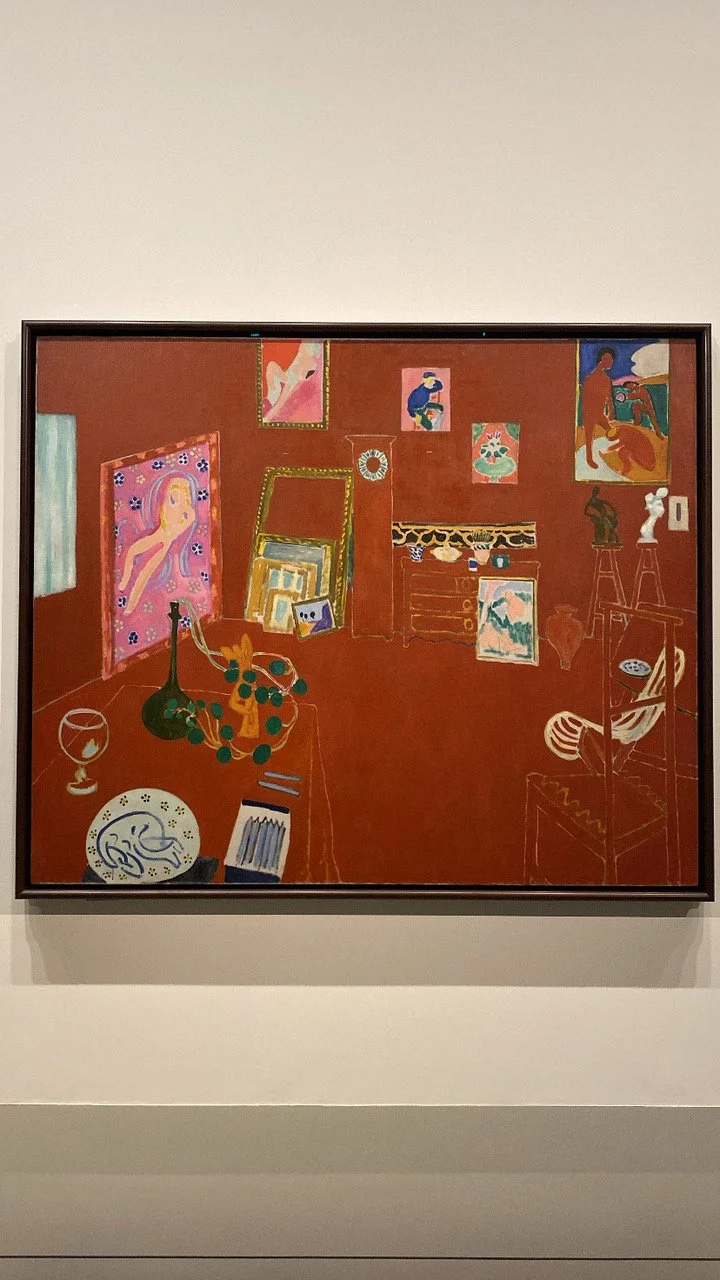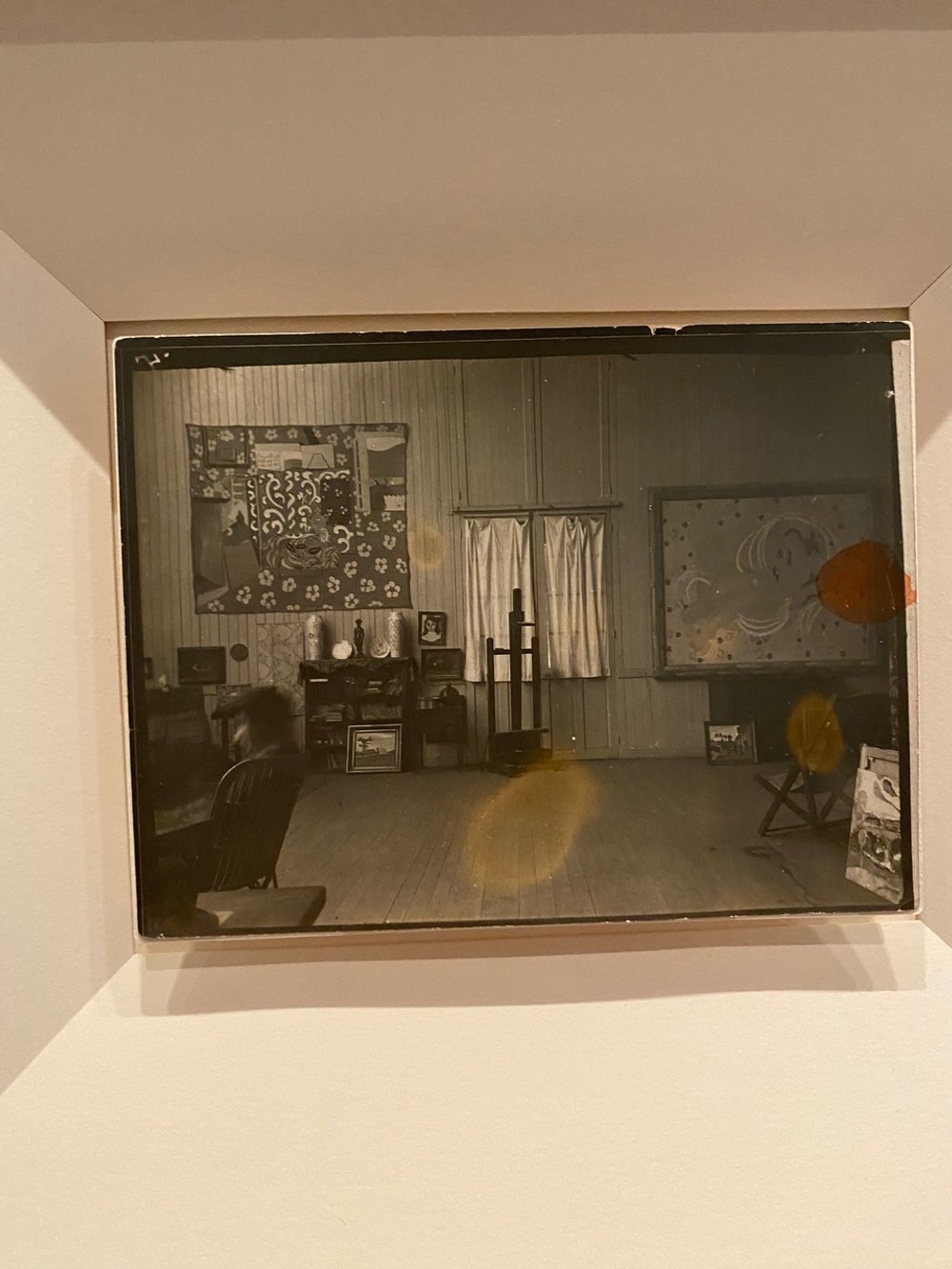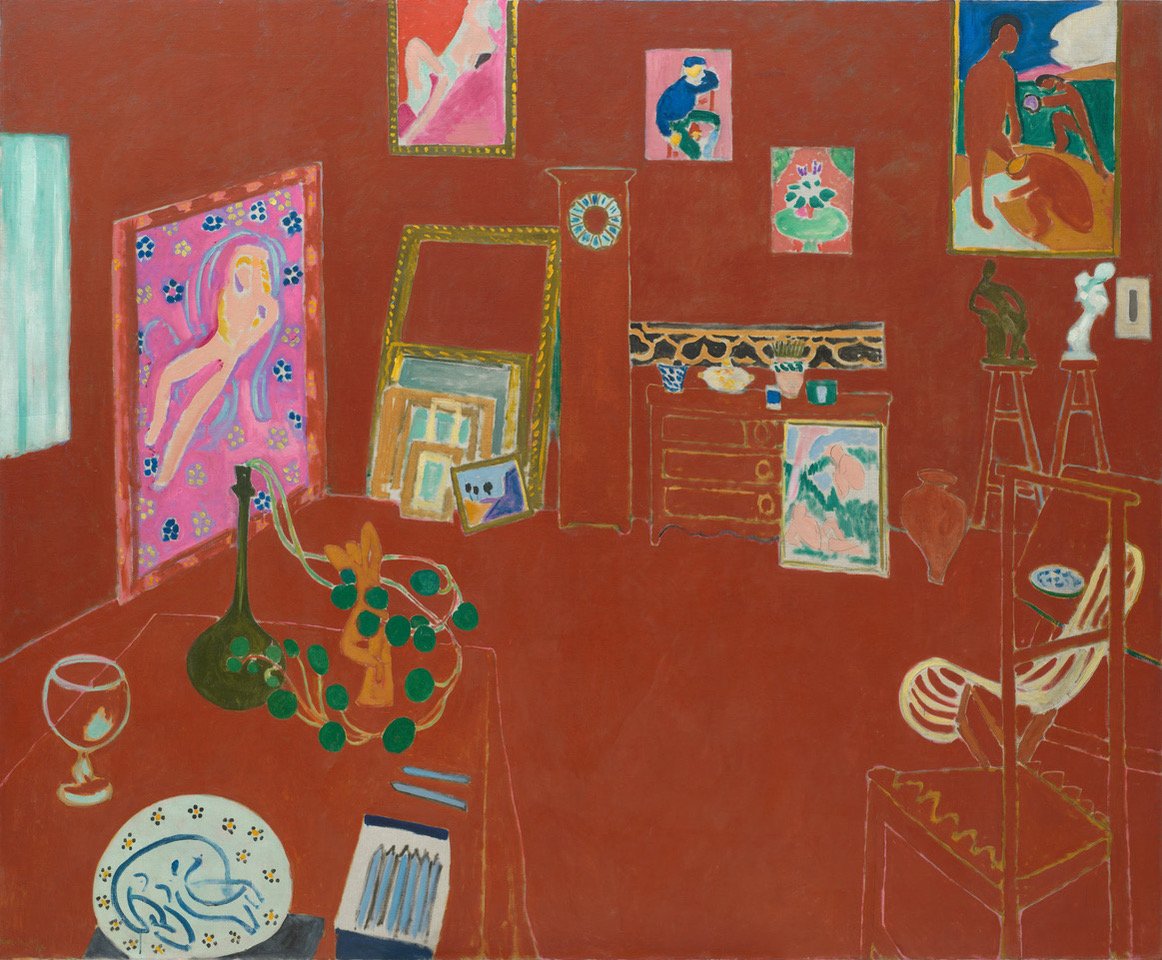Red Hot!
Matisse L’Atelier Rouge, Fondation Louis Vuitton until 3 Septembre 2024
Bienvenue and welcome back to Musée Musings, your idiosyncratic guide to Paris and art. Before I tell you about the absolutely fabulous Matisse exhibition and the really interesting Ellsworth Kelly exhibition both at the Fondation Louis Vuitton, I want to share a couple embarrassments.
Here’s the first one, when I was in Potsdam in May, I went to the Barberini Museum to see the exhibition on Modigliani. There was another exhibition, on Impressionism, that I quickly walked through. (Fig 1) Thinking that the best Impressionist paintings are in France. Turns out, the founder of the Barberini Museum was a passionate collector of French Impressionist art. With 39 paintings by Monet, this museum has the largest collection of Monets outside of Paris. At least I walked by.
Figure 1. Impressionismus 2024, Museum Barberini, Potsdam, Germany
The other embarrassment is worse. When I was in Copenhagen last year I decided not to go to art museums. I can walk from my apartment to the Louvre or the Musée d’Orsay, so it seemed crazy to go to Denmark to see Picassos and Renoirs. Well, I did go to the Louisiana Museum just outside of Copenhagen and found the museum of my dreams. But that’s a different story because it was highly recommended.
Where I definitely did not go was to the National Gallery of Denmark, (SMK). Whose collection of 19th/20th century French paintings, I learned as I researched the exhibition I am going to tell you about, is so huge because Johannes Rump, a businessman with a discerning eye, bequeathed his entire collection of French art to the museum. It’s a collection that is particularly rich in paintings by Matisse. (Fig 2)
Figure 2. Madame Matisse, (The Green Stripe) Matisse, 1905, SMK, Denmark
Thanks to two generous donors, SMK just bought The Bathers (formerly called Nymph and Faun) (Fig 3) one of the paintings in Matisse’s The Red Studio, (Fig 4) (1911), the painting which is the focus of the exhibition at the Fondation Louis Vuitton.
Figure 3. The Bathers, (formerly known as Nymph and Faun) Henri Matisse, 1907 SMK, Denmark
Figure 4. The Red Studio, Matisse, 1911, MoMA
The exhibition initially had two venues - MoMA, New York, which has owned The Red Studio since 1949 and SMK, Copenhagen, because it has so many paintings in the painting, The Red Studio. FLV must have been added as an afterthought. Maybe because the Fondation is just a 30 minute drive from the studio in the The Red Studio. Maybe because the Fondation had an exhibition on the wealthy Russian businessman, art collector, Sergei Shchukin who commissioned the painting and then didn’t accept it. Or maybe the third richest man in the world just asked (Bernard Arnault was the richest man until Macron called a snap election and French stocks plummeted).
I am particularly fond of exhibitions that focus on a single painting. Because of all the ripples, all the threads. This exhibition is a perfect example of following the threads. There are so many - historical and cultural, artistic and microscopic. And what a pleasure it is to concentrate on a painting by Matisse. An artist whose works I could look at forever. It’s the colors! It’s the patterns!! It’s why Edouard Vuillard’s paintings and those by other members of the Nabis make me so happy. (Fig 5)
Figure 5. Woman in a Striped Dress, Edouard Vuillard, 1895
In the first room of this exhibition, we are introduced to Matisse’s studio, his first real studio. (Figs 6, 7) Before this studio, he painted in one room or another in the various apartments he shared with his family. And twice he made a studio in a State owned former convent. In the latter of which, the Couvent du Sacre Coeur, he was comfortably living, working and teaching when the eviction notice arrived in 1909. Auguste Rodin occupied the ground floor of the convent’s school. Rodin negotiated with the State. If he could stay, when he died, he would bequeath everything he owned to the State. The State agreed and at Rodin’s death, the Hôtel Biron became the Musée Rodin.
Figure 6. Photograph of Matisse in front of his studio, Issy-les-Moulineaux, France
Figure 7. Photograph of the interior of Matisse Studio, Issy-les-Moulineaux, France
Matisse was ready to move on, to get away from the school and the students and the colleagues who were taking up so much of his time. And his patron, the above mentioned Sergei Shchukin had been buying and was commissioning enough paintings for Matisse to build a studio of his own. But to build a studio as big as the former convent space had been, Matisse had to move out of Paris. And that’s how he came to build his studio in Issy-les-Moulineaux. The studio was on a double lot. A house for his family on one lot, a studio built to his specifications on the other. Matisse’s studio had an iron framework and a corrugated sheet metal roof. The interior ceiling was wood, the floor, red fir, the walls mostly glass. It was built in 2 months.
So that’s the unromantic studio that is the subject of this very romantic painting. A painting, or more accurately, a portrait of an artist’s studio is very intimate. According to Ann Temkin, MoMA’s chief curator of painting and sculpture, “The studio is the heart of the artist’s life. It’s not just any interior. It’s the core of what they’ve made their world. When an artist chooses to make a work that’s about the studio, it’s almost by definition a work about art in a much broader way.”
At the far end of the first room in this exhibition is the painting, The Red Studio. As you make your way, your pilgrimage, to the painting, there are as many of the paintings (6), sculptures (3) and ceramics (1) as could be located and borrowed, from public institutions and private collections. (Fig 8) Reunited for the first time since they left Matisse’s studio. The oldest work is the 1898, “Corsica, the Old Mill,” from Matisse’s Impressionist phase. The “Young Sailor II,” is a celebration of the artist’s Fauvist period. The painting was apparently “so provocative,” (according to one reviewer) that “when (it was) unveiled in 1906 (Matisse) pretended his postman had painted it. There is The Nude with a White Scarf from 1909 to our left of the Young Sailor. And a plate from 1907 with a nude curled perfectly around its contours. Le Lux II, also from 1907 is here. And from 1911, the year the Red Studio was painted is the sculpted bust, “Jeanette (IV)”, whose features and hair have been condensed into abstractions. (Figs 9-14).
Figure 8. The Red Studio exhibition, Fondation Louis Vuitton, France
Figure 9. Corsica, the Old Mill, 1898
Figure 10. Young Sailor II, 1906
Figure 11. Nude with a white scarf, 1909
Figure 12. Jeanette IV, 1911
Figure 13. Female Nude, plate 1907
Figure 14. Le Lux II, 1907
One painting, Large Nude, (Fig 15) the biggest painting in The Red Studio isn’t here. Normally its absence would be disappointing if there wasn’t such a good reason. Again, Ann Temkin, “Matisse asked to have the painting destroyed after his death. We're not exactly sure why—if Matisse felt it was unresolved or it became damaged.”
Figure 15. Large Nude, detail of photograph of Matisse’s studio Issy-les-Moulineaux
Blake Gopnik (NYT) has a theory. The nude in Large Nude is Matisse’s daughter who would have been 16 or 17 when Matisse painted her. Gopnik thinks it’s her because her name was Marguerite and the painting’s nude is encircled by daisies, marguerites in French. And also because Gopnik, “had seen those flowers before, in reproductions of The Painter’s Family, (Fig 16) a slightly earlier Matisse … now at the Hermitage.. (which had been owned by Shchukin) They were all over the dress of a teenage girl who sits doing needlework toward its rear.”
Figure 16. The Painter’s Family, Matisse, 1911
Gopnik contends that Matisse intended his daughter’s nude body to be the focus of The Red Studio. And that he placed the empty rattan chair directly in front of Large Nude so that someone could enjoy looking at her at their leisure. And since The Red Studio was conceived as a companion piece to The Painter’s Family, the intended viewer must have been Sergei Shchukin, Matisse’s patron. Maybe Shchukin balked at acquiring this painting because its subject or at least its insinuation was too obvious, at least to him. (There is a chair in front of the painting in the photograph of the studio)
Reading this theory without a context is just too kinky. So let me provide one. Paintings of female nudes from the Renaissance through Courbet’s Origin of the World were meant for the private delectation of the painting’s owner. (Figs 17, 18) But as the art historian, Carol Duncan, noted (Art Forum, 1973) beginning at the turn of the 20th century with the Fauves in France and Der Brücke in Germany, artists began to insert themselves into their portraits of nudes. (Fig 19) And the owners of these paintings became voyeurs rather than participants. Matisse might have been balancing both traditions - it would be Sergei’s painting but it was Matisse’s daughter. Of course there are other possibilities. The painting was just too personal for the artist and Matisse asked for it to be destroyed, just as Jane Austen’s letters were burned by her sister Cassandra, presumably at Austen’s request. Or perhaps both Matisse’s daughter and Austen’s sister took it upon themselves to destroy what was too personal for them.
Figure 17. Sleeping Venus, Giorgione
Figure 18. Origind du Monde, Gustave Courbet, 1866.
Figure 19. Self Portrait with Model, Ernst Kirchner, 1910
So, that’s the painting and that’s the first room of the exhibition. In the next room, we follow the painting’s odyssey from its initial rejection by Sergei Shchukin to all all the places it was hung and the people who owned it. Here goes - in 1912, The Red Studio (Fig 20) was exhibited in London, (Fig 21). Nobody was impressed. The next year, it traveled to New York for the Armory Show (Fig 22), it was met with derision and disdain. After that, Matisse didn’t show the painting again for another 12 years.
Figure 20. The Red Studio, Matisse, 1911, Issy-les-Moulineaux
Figure 21. Room in the Second Post-Impressionist exhibition London, Roger Fry, 1912 (Red Studio on right)
Figure 22. The Red Studio at the Armory Show, NYC (Brancusi portrait bust on right, just in front of Matisse’s painting)
Did Proust write anything that could be quoted here? You betcha! In the exhibition catalogue, Proust weighs in about Matisse’s contemporaries. He notes that it’s often the case that they simply “lacked the necessary perspective (…), as certain paintings are judged poorly when one is too close.”
Ann Temkin explains it this way, “So many of the landmark works of modern art were despised or ignored for a long time. A picture’s life takes form because of the places it goes and the people who get to see it.…Art history isn’t some clean line that happens in some predetermined direction. It’s all of these twists and turns and accidents and surprises. You could call it the history of taste or collecting.…”
Finally, in 1927, a man called David Tennant, who had just opened a members only club in London, the Gargoyle club, bought the Red Studio. It remained there, through the early 1940s seen by the club’s members (Fig 23). But eventually Tennant wanted to redecorate. He asked Matisse to buy back his canvas. Matisse refused.
Figure 23. Gargoyle Club interior (Red Room on wall at far left)
In 1945, the painting was purchased by a New York gallery. It took four years but they finally found a buyer, the Museum of Modern Art in New York. Where it has held pride of place ever since. And unlike Picasso’s Guernica, this painting isn’t going anywhere.
In another room, a video plays on a loop. A small group of enthusiastic MoMA conservators explain how they discovered the painting’s secrets after extensive technical analyses. Shades of blue, pink and ochre peek through the red paint. Drips of those same colors are at the painting’s edges. What that means is that Matisse first painted the walls blue, the floor pink and the furniture ochre. The original painting was similar to the more naturalistic The Pink Studio, (Fig 24) which Matisse had painted for Shchukin earlier that year and which was already in Russia. In that painting, the floor is one color, the walls are another. You can see a tree outside the window. The screen and fabric and all of the paintings, sculptures and furniture are clearly distinguishable.
Figure 24. The Pink Studio, Matisse, 1911
The red in The Red Studio, (Fig 20 above) “was applied in a fit of inspiration a month or more after the previous layers dried. Matisse apparently slathered on the red with such speed and vigor that paintbrush hairs were ripped out and caught in the paint.” And now, the floor and walls read nearly as one along with most of the furniture (although not the rattan chair). The paintings and sculptures and ceramic plate are discernible as is the face only of a grandfather clock, a fishbowl with one lone fish, a box of crayons and a plant whose tendrils wrap around a statuette.
We still don’t know why Matisse covered a finished painting with a layer of red paint. For Temkin, “what never goes away is the sense of awe at the gamble he took’. For her, the painting offers ‘an exemplary story of how artists work”.
Matisse didn’t seem to know why he painted over it either. According to Alistaire Sooke (Interiors) Matisse said to the visiting Hungarian writer Vilma Balogh, “Here is a picture I am in trouble with. I like it but I don’t quite understand it.”
In 1948, Matisse returned to the theme of the artist’s studio, in his Large Red Interior (Fig 25). It was Matisse’s last oil painting. Nearly 40 years separates it from The Red Studio. Both paintings have inspired generations of artists.
Figure 25. Large Red Interior, 1948
In the exhibition’s final section, we learn about how important Red Studio has been since artists began seeing it at MoMA in 1949.
According to Ann Temkin, “Now over 110 years old, The Red Studio is both a landmark within the centuries-long tradition of studio paintings and a foundational work of modern art…The picture remains a touchstone for any artist taking on the task of portraying their studio. Matisse’s radical decision to saturate the work’s surface with a layer of red has fascinated generations of scholars and artists, including Mark Rothko and Ellsworth Kelly.” (Fig 26)
Figure 26. Ellsworth Kelly at the Fondation Louis Vuitton
Oh dear, I’ve run out of space, I’ll tell you about the Kelly exhibition next time!
It’s another tense Sunday here in France as we await our political fate. Every one of the 577 deputies who represent the country was up for election (or re-election) last Sunday. Each party, and there are 5 or 6, had the right to put forward 577 candidates for last week’s first round of voting. A few candidates received more than 50% of the cast ballots and so were elected (most of them were far right candidates). But the vast majority of the 577 positions are still open. For a candidate’s name to appear in today’s run off, they had to have received at least 12.5% of the votes last week. There’s some horse trading going on among the parties now. (Fig 27) Between the shades of left and center, as candidates from those parties, in 3rd and 4th place, agree to withdraw so that the strongest candidate opposing the far right candidate will have the greatest chance of winning.
My friends are lamenting the fact that so many of the people running for the 577 deputy positions, mostly those on the far right, (Fig 28) have no experience, no expertise. So, as with pop culture and junk food; obesity and drug addiction. France follows America in this dummying down of qualifications for public office. Where else but the US House of Representatives could a pest control specialist win a seat or a high school basketball coach (later accused of sexual abuse) become speaker. Sadly, the short answer is - France. There is a strong possibility that the next Prime Minister of France will be a 28 year old who dropped out of college to devote himself full-time to far right politics. And so it goes. Gros bisous, Dr. B.
Figure 28. A candidate from Caen wearing a Nazi cap, Marjorie Taylor Greene’s French cousin?
Copyright © 2024 Beverly Held, Ph.D. All rights reserved
Dear Reader, I hope you enjoyed reading this article. Please sign up below to receive more articles plus other original content from me, Dr. B. Merci!
And, if you enjoyed reading this review, please consider writing a comment. Thank you!




























